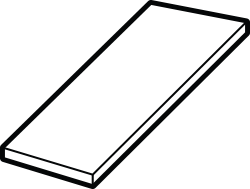
Sheet offers a combination of increased strength, corrosion resistance, and machine-ability, which makes it widely used. Sheet is heat treatable, resists cracking due to stress, is easy to weld and machine, but limited on formability. Sheet is ideal for structural framing, base plates, gussets, motorcycle and automotive parts and more.
| Grade | Description |
|---|---|
| 1008 | Low-carbon steel containing approximately 0.40% manganese that has excellent weldability and formability. |
| 1011 | Hot-rolled carbon steel alloy sheet that exhibits high strength and high formability. |
| A606 | Corrosion resistant. High strength steel. Excellent for welding, riveting, or bolting. |
| AR-MED | High strength, low-alloy steel. Abrasion resistant. Made in the as-rolled condition. |
| HSLA GR50 | Medium carbon steel that can be forged satisfactorily. Most common shafting steel. |
| Grade | Description |
|---|---|
| 260 | Wide range of applications. High ductility. Low to fair soldering and brazing capabilities. |
| Grade | Description |
|---|---|
| 110 | Broad range of uses. Excellent hot and cold forming characteristics. Poor machinability rating. |
| Grade | Description |
|---|---|
| 1100 | Commercially pure aluminum. Soft and ductile, has excellent workability and formability and high thermal and electrical conductivities. Non-heat treatable. |
| 2024 | One of the most commonly used high strength aluminum alloys. Low corrosion resistance. Commonly used when good strength-to-weight ratio is desired. |
| 3003, 3105 | Most widely used of all aluminum alloys. Excellent corrosion resistance and good workability. Added manganese to increase strength 20% more than 1xxx grade. |
| 5005, 5052, 5086 | Highest strength alloy of the more non-heat treatable grades. Good resistance to marine atmosphere and salt water corrosion. Good workability. |
| 6061 | Heat treatable, structural alloy with medium strength and good weldability, formability, machinability, and relatively good corrosion resistance. |
| 7075 | Highest strength in heat treatable alloys. Adequate machinability and improved stress corrosion control. Good for highly stressed structural parts. |
| Grade | Description |
|---|---|
| 304 | Offers resistance to corrosion, has good formability and can be readily welded by all methods. One of the most commonly used grades across the industry. |
| 304L | Extra low carbon avoids harmful carbide precipitation due to welding. Same corrosion resistance as 304 with lower mechanical properties. |
| 309 | Used for high temperature and high scale resistance applications. Corrosion resistance is superior to that of 304. Resists corrosion on welded parts. |
| 316L | Extra low carbon avoids harmful carbide precipitation due to welding. Same excellent corrosion resistance as 316. It exhibits the same high strength, toughness and workability as 304 alloys. |
| 321 | Stabilized using titanium for weldments subject to harsh corrosion. No carbide precipitation and immune to organic and inorganic chemicals. |
| 430 | Most popular of the non-hardenable stainless steels. Has great corrosion and heat resistance with good mechanical properties. |